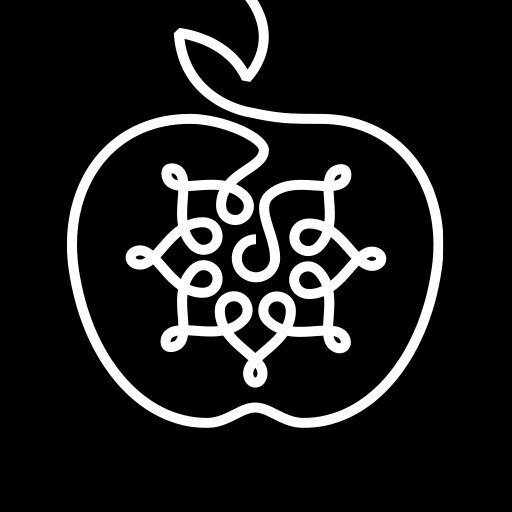Care
Кайгырту
How an apple orchard became a symbol of Almetyevsk's urbanization and a metaphor for care and well-being
What filled the surreal collage about the cultivation of the «garden of life»
Marat Morik (Prague, Czech Republic)
39 Israel Zaripov Avenue
Context
The apple orchard: the main symbol of Almetievsk that combines the traditions of Islam, the urbanization era and the concept of taking care of yourself and others.

In the 20th century, the village of Almetyevo began to rapidly transform into a city. Mass planting of apple trees on the central streets and alleys became one of the symbols of this transformation. Residents still often remember planting the seedlings of fruit trees that are still growing throughout town today.
The garden image occupies a special place in Islam – it is encountered in theological texts, in poetry, and in the works of artists. As Alfried Bustanov, researcher, philosopher, and Islamic culture expert, notes, gardens for Muslims are spaces that form character, a space for reflection, and thus for the development of the mind and soul.
The garden image occupies a special place in Islam – it is encountered in theological texts, in poetry, and in the works of artists. As Alfried Bustanov, researcher, philosopher, and Islamic culture expert, notes, gardens for Muslims are spaces that form character, a space for reflection, and thus for the development of the mind and soul.
Lenin Street planted with Ranetki apple trees, 1986. Photo from the «Almetyevsk 1986» album in the Beloved Almetyevsk town group in VKontakte.
In the 20th century, the village of Almetyevo began to rapidly transform into a city. Mass planting of apple trees on the central streets and alleys became one of the symbols of this transformation. Residents still often remember planting the seedlings of fruit trees that are still growing throughout town today.
The garden image occupies a special place in Islam – it is encountered in theological texts, in poetry, and in the works of artists. As Alfried Bustanov, researcher, philosopher, and Islamic culture expert, notes, gardens for Muslims are spaces that form character, a space for reflection, and thus for the development of the mind and soul.
The garden image occupies a special place in Islam – it is encountered in theological texts, in poetry, and in the works of artists. As Alfried Bustanov, researcher, philosopher, and Islamic culture expert, notes, gardens for Muslims are spaces that form character, a space for reflection, and thus for the development of the mind and soul.

Lenin Street planted with Ranetki apple trees, 1986. Photo from the «Almetyevsk 1986» album in the Beloved Almetyevsk town group in VKontakte.

In Marat Morik's «Care», Almetyevsk's historical past and the symbolic meaning of the garden in Islam are intertwined and transformed into the universal concept of cultivating the «garden of life». The artist recalls that a person has the right to independently shape his own well-being and grow his own garden. For Marat, taking care of oneself is inseparable from taking care of the town and nature – taking care of the yard becomes a representation of one's own microcosm and each other.
Photos of the mufti, poet and preacher Gabdelbari Isaev in his own apple orchard. In the family album, photographs of the same year were accompanied by the author's poetic lines:
In Marat Morik's «Care», Almetyevsk's historical past and the symbolic meaning of the garden in Islam are intertwined and transformed into the universal concept of cultivating the "garden of life." The artist recalls that a person has the right to independently shape his own well-being and grow his own garden. For Marat, taking care of oneself is inseparable from taking care of the town and nature – taking care of the yard becomes a representation of one's own microcosm and each other.

Photos of the mufti, poet and preacher Gabdelbari Isaev in his own apple orchard. In the family album, photographs of the same year were accompanied by the author's poetic lines:
Look at my fate,
Where it brought me:
After various trials
It brought me here.
In my garden that I built myself
Between the apple trees
You'll know what is it I am doing
When you look at the photograph.
Bari
Where it brought me:
After various trials
It brought me here.
In my garden that I built myself
Between the apple trees
You'll know what is it I am doing
When you look at the photograph.
Bari
Look at my fate,
Where it brought me:
After various trials
It brought me here.
In my garden that I built myself
Between the apple trees
You'll know what is it I am doing
When you look at the photograph.
Bari
Where it brought me:
After various trials
It brought me here.
In my garden that I built myself
Between the apple trees
You'll know what is it I am doing
When you look at the photograph.
Bari
Process
Art form: mural
Style: surrealism
Technique: surreal collage with elements of photorealism
Material: façade paint
Style: surrealism
Technique: surreal collage with elements of photorealism
Material: façade paint
Ital. Mural — wall
Monumental wall painting created on a faсade or a blank wall of a building or any other urban architectural objects.
Monumental wall painting created on a faсade or a blank wall of a building or any other urban architectural objects.

Before starting to work on a new project, Marat Morik familiarizes himself with the location, walks around and observes. Then he comes up with a sketch based on his impressions. While working on the «Care» mural, Marat went to the country house in the estate of the famous preacher Yosyf Hazrat, where the artist was given a tour of the garden that Yosyf grows.
At the estate, one can see how the ancient idea of a Muslim garden is put into practice today – each tree here has its own symbolic meaning, which the artist learned. The impressions of this visit formed the basis for the concept of the mural. «Care is a two-way process – when you care about something, it cares about you. Taking care of the environment means taking care of your surroundings, city, house, yard. It's a sort of a collective work that later reciprocates,» the artist explains.
Marat Morik worked in Almetyevsk for 14 days. In total, the mural required 200 liters of paint. It depicts children planting apple trees, an important symbol for the people of Tatarstan. A dog is running around them. «The prototype is my own dog, which we took home from a shelter at one time. Taking care of her made me very emotional,» notes Marat.
At the estate, one can see how the ancient idea of a Muslim garden is put into practice today – each tree here has its own symbolic meaning, which the artist learned. The impressions of this visit formed the basis for the concept of the mural. «Care is a two-way process – when you care about something, it cares about you. Taking care of the environment means taking care of your surroundings, city, house, yard. It's a sort of a collective work that later reciprocates,» the artist explains.
Marat Morik worked in Almetyevsk for 14 days. In total, the mural required 200 liters of paint. It depicts children planting apple trees, an important symbol for the people of Tatarstan. A dog is running around them. «The prototype is my own dog, which we took home from a shelter at one time. Taking care of her made me very emotional,» notes Marat.
Teatime at the estate of preacher Yosyf Hazrat, where the artist and his team learned about the history and tradition of growing gardens.

Marat Morik at work on the «Care» mural, summer 2022.
Before starting to work on a new project, Marat Morik familiarizes himself with the location, walks around and observes. Then he comes up with a sketch based on his impressions. While working on the «Care» mural, Marat went to the country house in the estate of the famous preacher Yosyf Hazrat, where the artist was given a tour of the garden that Yosyf grows.
At the estate, one can see how the ancient idea of a Muslim garden is put into practice today – each tree here has its own symbolic meaning, which the artist learned. The impressions of this visit formed the basis for the concept of the mural. «Care is a two-way process – when you care about something, it cares about you. Taking care of the environment means taking care of your surroundings, city, house, yard. It's a sort of a collective work that later reciprocates,» the artist explains.
Marat Morik worked in Almetyevsk for 14 days. In total, the mural required 200 liters of paint. It depicts children planting apple trees, an important symbol for the people of Tatarstan. A dog is running around them. «The prototype is my own dog, which we took home from a shelter at one time. Taking care of her made me very emotional,» notes Marat.
At the estate, one can see how the ancient idea of a Muslim garden is put into practice today – each tree here has its own symbolic meaning, which the artist learned. The impressions of this visit formed the basis for the concept of the mural. «Care is a two-way process – when you care about something, it cares about you. Taking care of the environment means taking care of your surroundings, city, house, yard. It's a sort of a collective work that later reciprocates,» the artist explains.
Marat Morik worked in Almetyevsk for 14 days. In total, the mural required 200 liters of paint. It depicts children planting apple trees, an important symbol for the people of Tatarstan. A dog is running around them. «The prototype is my own dog, which we took home from a shelter at one time. Taking care of her made me very emotional,» notes Marat.

Teatime at the estate of preacher Yosyf Hazrat, where the artist and his team learned about the history and tradition of growing gardens.

Marat Morik at work on the «Care» mural, summer 2022.
Author

Marat Morik (Danilyan) is one of the world's most famous Russian street artists who hails from Novosibirsk. For the last 10 years he has been living and painting in Prague. His works can be seen in the USA, Canada, Malaysia, as well as in European countries – France, the Czech Republic, Spain, Denmark. The artist himself describes his method as a collage style. His works can be recognized by fantastic stories depicted in vivid collages. Morik's street art is closely intertwined with book graphics. Morik also does illustrations, paints on canvas and works with ceramics.
Marat Morik's works throughout the world.
Marat Morik (Danilyan) is one of the world's most famous Russian street artists who hails from Novosibirsk. For the last 10 years he has been living and painting in Prague. His works can be seen in the USA, Canada, Malaysia, as well as in European countries – France, the Czech Republic, Spain, Denmark. The artist himself describes his method as a collage style. His works can be recognized by fantastic stories depicted in vivid collages. Morik's street art is closely intertwined with book graphics. Morik also does illustrations, paints on canvas and works with ceramics.

Marat Morik's works throughout the world.
Address
CONTACT US
© 2025 Street Art Research Institute
Made by Gonzo Design
Banking details
ООО «ТЕОРИЯ И ПРАКТИКА УЛИЧНОГО ИСКУССТВА»
ИНН: 7810474682
КПП: 784201001
ОГРН: 1167847291545
ОКПО: 03512611
ОКВЭД: 90.0 (Деятельность творческая, деятельность в области искусства и организации развлечений)
Расчетный счет: 40702810455160005262
Банк: СЕВЕРО-ЗАПАДНЫЙ БАНК ПАО СБЕРБАНК
БИК: 044030653
Корр. счет: 30101810500000000653
Юридический адрес: 191040, Санкт-Петербург г, Лиговский пр-кт, дом 50, литера Н, помещение 16-Н офис № 56
Телефон: 401-44-90
Генеральный директор: Фиева Полина Григорьевна






